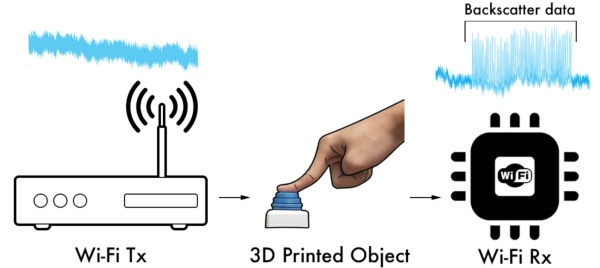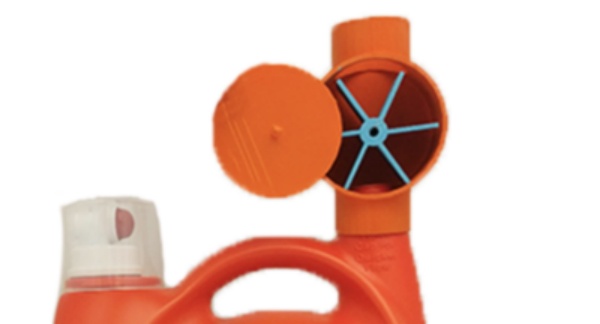Which word is missing in "The Internet of Plastic Things"?
The same word that is missing in the Internet of NON-plastic things, of course.
The “Internet of Things” (IoT) is a vision to collect, store and exchange data among, potentially, every object.
Cool. But how can you do that, with must-be-cheap, 100% plastic products that never before had any need, space or budget for batteries or transistors?
Luckily, some researchers at the University of Washington have found a way to make such objects send data to smartphones or other Wi-Fi devices.

Current samples include “a battery-free slider that controls music volume, a button that automatically orders more cornflakes from an e-commerce website and a water sensor that sends an alarm to your phone when it detects a leak”.
OK. But…
How does it work, in practice?
Losely speaking, the idea is similar to what already powers, for example, contactless credit cards.
This time, traditional electronic components and batteries are replaced by 3-D printed, plastic surrogates, by embedding in plastic conductive materials like copper or graphene, in order to:
- encode “the 0 and 1 bits” traditionally stored inside transistors as missing or present tooths of small, 3D printed, hidden plastic gears
- add small “plastic” antennas, that embed conductive materials like copper or graphene
- couple those antennas to the gears in such a way than, when the latter move, the antenna changes form according to the tooths sequence, thus transmitting back a radio version of those same bits
- get the energy to power those gears by transforming mechanical motion from e.g. bottle caps being unscrewed, pushed buttons, or plastic springs, like the one in this picture:

Commercial applications? Plenty
E-commerce websites could know how a (obviously consenting) user might be interacting with the objects they sell, and know when their bottles of detergent, or pills, need a refill.
Cool as heck! IF…
The geek in me really admires the whole idea. The rest of me can’t help pointing out that, in too many cases, “electronics and batteries not included” still is a feature, much more than it is a bug.
So far, way too many applications of current “consumer-oriented” Internet of Things" have three problems:
- they are useless, intrinsically stupid stuff. Seriously. Rather than funding crap like this, give that money to me. I DO mean it
- they greatly increase pollution, really making of IoT the new plastic. The first signal that everything with copper or graphene 3D-printed inside transmits is “Look how unrecyclable I just became!" It increases wishcycling, in a world that was already drowning in plastic (A)
- they increase surveillance and iscrimination: “e-commerce websites would like to know how a user might be interacting with the objects they sell (after the user has given consent of course)". “Of course”? As in “only those with a stable enough income to afford refusing the discounts that come with consent won’t be tracked”?
The word missing in the “Internet of Things, Plastic or not” is “useful”. If something is not actually useful, or you aren’t sure it solves more pre-existing problems that it creates, it’s not smart. Don’t buy nor use it.
(A) Update, 2020/12/22: all of the above, plus the fact that microplastic has been found even in placentas of unborn babies.
Who writes this, why, and how to help
I am Marco Fioretti, tech writer and aspiring polymath doing human-digital research and popularization.
I do it because YOUR civil rights and the quality of YOUR life depend every year more on how software is used AROUND you.
To this end, I have already shared more than a million words on this blog, without any paywall or user tracking, and am sharing the next million through a newsletter, also without any paywall.
The more direct support I get, the more I can continue to inform for free parents, teachers, decision makers, and everybody else who should know more stuff like this. You can support me with paid subscriptions to my newsletter, donations via PayPal (mfioretti@nexaima.net) or LiberaPay, or in any of the other ways listed here.THANKS for your support!